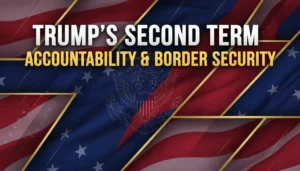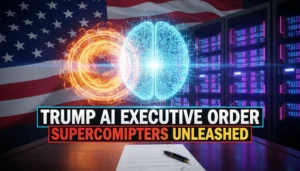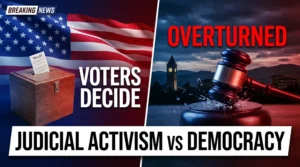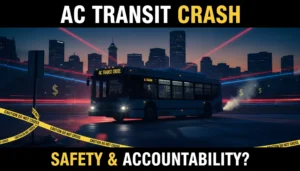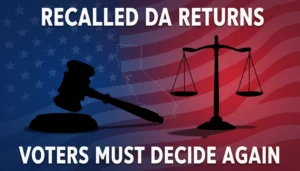Trump’s Strategic Government Shutdown: Cutting ‘Democratic Agencies’ to Drain the Swamp

How the 47th President is Using Constitutional Powers to Permanently Reduce Federal Bloat and Restore Constitutional Government
October 2, 2025
President Donald Trump’s decision to initiate a targeted government shutdown this week represents far more than typical Washington budget theater. This is the fulfillment of a campaign promise that resonated with millions of Americans who voted for real change, not just different management of the same bloated federal bureaucracy that has grown increasingly hostile to conservative values and constitutional governance.
Unlike previous shutdowns that were largely political posturing, Trump’s current strategy demonstrates a sophisticated understanding of executive power and a commitment to permanently restructuring a federal government that has become weaponized against the American people. By specifically targeting what he calls “Democratic agencies” – federal departments that have become partisan enforcers of progressive ideology rather than neutral public servants – Trump is delivering on his promise to drain the swamp once and for all.
The Constitutional Foundation for Action
The genius of Trump’s approach lies in its constitutional grounding. Article II of the Constitution grants the President broad executive authority over federal agencies, and Trump is exercising this power with surgical precision. Rather than the broad-brush shutdowns of previous administrations, this targeted approach focuses on agencies that have demonstrably exceeded their constitutional mandate and become tools of partisan warfare.
The Department of Education, for instance, has transformed from an agency meant to support local education into a vehicle for pushing critical race theory, gender ideology, and other progressive orthodoxies onto America’s schoolchildren. The Environmental Protection Agency has become a job-killing machine that prioritizes radical climate activism over American energy independence. The Department of Justice has been weaponized to target political opponents while ignoring real crimes committed by Democratic elites.
These agencies have forgotten that they serve the American people, not the Democratic Party. Trump’s shutdown sends a clear message: return to your constitutional role or face elimination.
Draining the Swamp, Not Managing It
What sets this shutdown apart from previous political standoffs is Trump’s explicit goal of permanent reduction rather than temporary pressure. Previous Republican presidents have talked about smaller government but ultimately accepted the status quo of ever-expanding federal bureaucracy. Trump is different. He understands that you cannot reform a system that is fundamentally corrupt – you must replace it.
The timing is particularly strategic. Coming early in his second term, Trump has maximum political capital and the mandate of a decisive electoral victory. The American people didn’t elect him to manage decline or negotiate with a hostile bureaucracy. They elected him to restore constitutional government and end the administrative state’s war on American values.
By framing this as cutting “Democratic agencies,” Trump is accurately describing institutions that have become partisan actors rather than neutral public servants. When the FBI raids the home of a former president while ignoring Hunter Biden’s laptop, when the IRS targets conservative groups while giving liberal organizations a pass, when the CDC becomes a vehicle for authoritarian lockdown policies – these are not neutral government agencies. They are Democratic Party enforcement arms operating under the guise of federal authority.
Economic Benefits of Strategic Downsizing
The fiscal implications of Trump’s approach cannot be understated. The federal government has grown exponentially over decades, creating layers of bureaucratic redundancy that drain taxpayer resources while producing little value for ordinary Americans. By eliminating entire agencies or dramatically reducing their scope, Trump is not just saving money – he’s redirecting resources from bureaucratic empire-building to productive economic activity.
Consider the Department of Education, which consumes over $80 billion annually while American students continue to lag behind international competitors. Eliminating this department and returning education policy to states and local communities would not only save taxpayers billions but would restore educational excellence by removing federal interference in local decision-making.
Similarly, the Environmental Protection Agency’s regulatory overreach has cost American manufacturers countless jobs and driven energy production overseas, weakening both our economy and national security. Streamlining or eliminating these regulatory barriers would unleash American energy production and manufacturing, creating good-paying jobs while reducing our dependence on hostile foreign nations.
Restoring Federalism and Constitutional Government
Trump’s shutdown strategy also serves a crucial constitutional purpose: restoring the proper balance between federal and state authority. The founders never intended for a massive federal bureaucracy to micromanage every aspect of American life. They envisioned a limited federal government focused on truly national concerns while leaving most governance to states and local communities.
By eliminating agencies that have usurped state and local authority, Trump is not weakening government – he’s strengthening it by returning power to levels of government that are more responsive to the people. When education policy is made in local school boards rather than Washington bureaucracies, parents have real influence. When environmental regulations are crafted by state legislatures rather than federal agencies, local economic conditions and priorities can be properly considered.
This restoration of federalism is essential for healing America’s political divisions. Much of our current polarization stems from the fact that every policy dispute becomes a national battle because so much power has been concentrated in Washington. By returning authority to states and localities, Trump is reducing the stakes of federal politics while empowering Americans to govern themselves according to their values and priorities.
The Political Courage to Act
What makes Trump’s approach particularly noteworthy is his willingness to accept short-term political costs for long-term constitutional benefits. Previous Republican presidents have avoided confrontation with the administrative state, preferring to work within existing systems rather than challenge their fundamental legitimacy. Trump understands that this approach has failed and that real change requires real confrontation.
The mainstream media and Democratic politicians are predictably denouncing Trump’s actions as extreme or dangerous. This reaction reveals their true priorities: preserving a system that serves their interests rather than the American people. When Nancy Pelosi and Chuck Schumer defend the Department of Education or the EPA, they’re not defending effective governance – they’re defending their ability to impose their ideology through unelected bureaucrats.
Trump’s willingness to ignore these attacks and focus on his mandate demonstrates the kind of political courage that has been missing from Republican leadership for decades. He understands that the American people didn’t elect him to be popular with Washington insiders or media elites. They elected him to restore constitutional government and end the administrative state’s assault on American values.
A Model for Conservative Governance
Trump’s strategic shutdown provides a template for how conservative leaders can effectively challenge the administrative state. Rather than accepting the premise that big government is inevitable and focusing only on managing it more efficiently, Trump is demonstrating that bold action can achieve fundamental change.
This approach requires courage, strategic thinking, and a clear understanding of constitutional principles. It also requires leaders who prioritize their oath to the Constitution over their standing with the Washington establishment. Trump’s example shows that such leadership is possible and effective.
As this shutdown continues, Americans will see the truth that conservatives have long argued: most federal agencies are not essential to our daily lives or national security. The sky will not fall, essential services will continue, and life will go on – often better than before, without bureaucratic interference.
President Trump’s strategic government shutdown represents more than a budget dispute or political tactic. It’s a fundamental challenge to the administrative state and a restoration of constitutional government. By targeting agencies that have become partisan enforcers rather than public servants, Trump is fulfilling his promise to drain the swamp and return power to the American people where it belongs.
The success of this approach will determine not just the shape of Trump’s second term, but the future of conservative governance in America. If Trump can demonstrate that bold action produces real results, he will have provided a roadmap for future conservative leaders to follow. The stakes could not be higher, and the opportunity could not be clearer.





